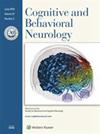白质、行为神经病学与皮质偏心症的影响
IF 1.7
4区 医学
Q4 BEHAVIORAL SCIENCES
引用次数: 1
摘要
人脑中的白质与灰质的体积大致相同,但在行为神经学和相关学科中受到的关注要少得多。特别是,大脑皮层长期以来一直主导着对大脑行为关系组织的思考。因此,与专门研究大脑皮层的大量工作相比,皮层下结构,包括深灰质,最值得注意的是白质,得到的神经科学研究相对较少。皮质中心主义的影响可以由几个因素来解释,包括神经病学中强烈强调皮质重要性的历史先例、选择性针对这种结构的研究方法的优势,以及对从正常大脑收集的比较神经解剖学数据的误解。本文将描述皮质中心偏向的背景,并强调白质在高等功能研究中有其自身的地位。尽管皮质中心主义继续对行为神经病学产生强大影响,但白质的研究正在取得相当大的进展——这一进展有望扩大我们对正常大脑的了解,并使我们更好地了解它如何介导行为。反过来,通过考虑白质束内的病理学或白质束功能障碍,一系列令人烦恼的神经和精神疾病可能会得到更好的解释。要完全理解大脑与行为的关系,不仅需要了解大脑半球的最外层,还需要了解白质连接,白质连接将灰质区域连接到为认知和情绪服务的分布式神经网络中。本文章由计算机程序翻译,如有差异,请以英文原文为准。
White Matter, Behavioral Neurology, and the Influence of Corticocentrism
White matter in the human brain occupies roughly the same volume as gray matter but has received far less attention in behavioral neurology and related disciplines. In particular, the cerebral cortex has long dominated thinking about the organization of brain–behavior relationships. As a result, subcortical structures, including deep gray matter and, most notably, white matter, have been accorded relatively little neuroscientific study compared with the extensive work devoted to the cerebral cortex. The influence of corticocentrism can be explained by several factors, including historical precedent in neurology strongly emphasizing the importance of the cortex, a preponderance of investigative methods that selectively target this structure, and a misinterpretation of comparative neuroanatomic data gathered from normal brains. This paper will describe the background of the corticocentric bias and emphasize that white matter merits its own place within the study of the higher functions. Although corticocentrism continues to exert a powerful impact on behavioral neurology, considerable progress is being made in the study of white matter—a development that promises to expand our knowledge of the normal brain and lead to an improved understanding of how it mediates behavior. In turn, a range of vexing neurologic and psychiatric disorders may become better illuminated by considering pathology within, or dysfunction of, white matter tracts. A complete appreciation of brain–behavior relationships requires an understanding not only of the outermost layer of the cerebral hemispheres, but also of white matter connectivity that links gray matter regions into distributed neural networks that subserve cognition and emotion.
求助全文
通过发布文献求助,成功后即可免费获取论文全文。
去求助
来源期刊
CiteScore
2.40
自引率
7.10%
发文量
68
审稿时长
>12 weeks
期刊介绍:
Cognitive and Behavioral Neurology (CBN) is a forum for advances in the neurologic understanding and possible treatment of human disorders that affect thinking, learning, memory, communication, and behavior. As an incubator for innovations in these fields, CBN helps transform theory into practice. The journal serves clinical research, patient care, education, and professional advancement.
The journal welcomes contributions from neurology, cognitive neuroscience, neuropsychology, neuropsychiatry, and other relevant fields. The editors particularly encourage review articles (including reviews of clinical practice), experimental and observational case reports, instructional articles for interested students and professionals in other fields, and innovative articles that do not fit neatly into any category. Also welcome are therapeutic trials and other experimental and observational studies, brief reports, first-person accounts of neurologic experiences, position papers, hypotheses, opinion papers, commentaries, historical perspectives, and book reviews.

 求助内容:
求助内容: 应助结果提醒方式:
应助结果提醒方式:


